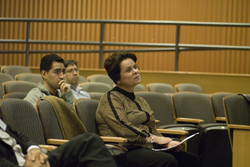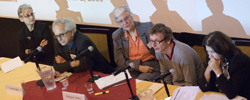The Voices of NYC Mexican Youth
Recently immigrated students and a range of scholars to discuss the needs of Mexican youth and families in the tri-state area
Two years ago, Oscar Chico entered the New York City United States , he was part of the wave of young Mexicans who have swept New York City
In October, Oscar and four other recently immigrated students from Mexico stood before an audience of Teachers College students, faculty and New York City educators and discussed their experiences in school—and almost all of them did so in English.
Oscar, a student at Pan American International High School in Queens , was clear about who helped him learn a new language so quickly. “My teachers,” he said. “They supported me.” Indeed, all of the students from Pan American High credited their teachers for helping them learn English—and so much more.
“Our teachers motivate us,” said Cesar Perez, another of the students on the panel. “My teachers always tell me they believe in me, and you start believing in yourself and want to move forward.”
The panel of immigrant students was one of several sessions at the two-day TC conference on the educational needs of Mexican youth and families in the tri-state area. The event was organized by the Latina/o and Latin American Faculty Working Group at TC.
Held in conjunction with the Children of Immigrants in Schools Conference at the City University of New York’s Graduate Center , The Educational Needs and Strengths of Mexican Youth and Families conference comes amid increasing Mexican immigration to New York City New York City New York City and 20 percent in New York State
Indeed, postsecondary educational opportunities—or the lack of them—for immigrant children was a focus of the conference. One of the panel discussions was on undocumented immigrants and higher education access.
One of the panelists, Jesús Pérez, Director of Academic Advising at Brooklyn College
Pérez said the dynamics have changed since he started working with Mexican immigrant students in the 1990s. Many of the students in those days were Mexican—born and chiefly Mexican educated. Today, most of the students were born—or grew up—in the United States
“In asking, ‘How we can get Mexican students to pursue higher education, we focused first high school, then on junior high, but neither was the answer. So we’re now focusing on elementary school. We keep digging to find where we need to be to support these students. It’s become obvious to us is that we need to start very early and that we need to start with the parents.”
Also in partnership with the CUNY conference, TC hosted a roundtable discussion, chaired by Lilliam Barrios-Paoli, Commissioner of New York City’s Department for the Aging, on what can be learned about Mexican-Americans and U.S.
The panelists were members of a research team studying how the children of low-wage immigrants are faring in the educational systems of six countries: France , Great Britain , the Netherlands , Spain , Sweden and the United States
One of their key findings: the achievement gap that exists in the United States between immigrant and native-born students also exists in Europe .
“Is there one or more of these systems that is doing better than the others?” asked Richard Alba, Distinguished Professor of Sociology at CUNY and principal investigator of the study. “The answer is that most of the systems are performing about the same. Despite the tremendous variations in the educational structures, when it comes to things like school-taught skills as measured by standardized tests or credentials that students can earn, they produce the same degree of inequality between native students and the children of low-wage immigrants.”
What, then, can schools do to narrow the achievement gap?
Carola Suárez-Orozco, Professor of Applied Psychology at New York University and a member of the research team, said she and her colleagues examined practices at two schools in New York City and two in Sweden
What Suárez-Orozco found is that the the most effective practice in the schools in both countries are similar. They include embedding language instruction across all the subjects instead of offering stand-alone English or Swedish classes, easing the cultural shock by offering such things as mentoring programs, providing opportunities for immigrant students to maintain some of their cultural practices and their first language, offering specific support to help the students address gaps in their education, and engaging with immigrant communities and families in culturally relevant ways.
“Schools need to do a better job of being respectful of parents and recognizing the way that parents sacrifice to provide an education for their kids,” Suárez-Orozco said. “We found that teachers kind of like the kids, but were very disparaging of parents. We have to have a realistic model of parent involvement that doesn’t include expecting parents to help with homework that is in another language and involves having a computer at home. That simply increases the disadvantage gap.”
Keynote speaker Kris Gutiérez, Professor and Provost’s Chair at the University of Colorado at Boulder
“Such reductive approaches constrain students’ opportunities to develop powerful literacies, access linguistic resources and to adopt new identities,” she said. “Further, the educational practices are bolstered by English-only ideologies, increasing xenophobic discourses, and national and local anti-immigrant sentiments that normalize English and English speakers and ‘otherize’ speakers of other languages.”
Anti-immigrant sentiment was certainly on the mind of some of the immigrant high school students during their panel discussion. One of the students, Francisco Curiel, told the audience that being undocumented is a constant struggle. Yet he bristled at the idea that he and his family—and other Mexican immigrants—were a drag on society, economically or otherwise.
“I want to tell anti-immigrant people that we don’t come here to take your jobs,” Francisco said, “we come here to have a better future and to clean your toilets and wash your dishes.”
The conference was sponsored by the Institute of Latin American Studies at Columbia University
For information on the Latina/o and Latin American Faculty Working Group or to view the conference program, visit www.tc.columbia.edu/latino-ed.
Published Tuesday, Nov. 24, 2009

